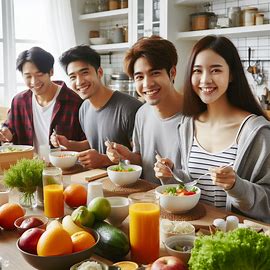Researchers suggest pairing vegetables with kid-friendly potato forms, such as potatoes in the shape of smiley faces, to increase children’s vegetable consumption. While the Dietary Guidelines for Americans recommends that children aged three to 18 consume 2.5 to three cups of vegetables daily, most school-aged children only eat one cup daily.
The research team evaluated how different potato presentations and preparations impacted the amount of vegetables kids consumed in a cafeteria. Serving potatoes shaped as faces in the same bowl as peas and carrots led to a measurable increase in total vegetables consumed.
“We wanted to learn more about how school meal offerings may influence kids’ eating behavior and possibly encourage greater vegetable consumption,” explains lead author Gene Ahlborn, associate professor at the department of nutrition, dietetics and food science at Brigham Young University, US.
“Getting kids to eat their vegetables is always a challenge,” adds Ahlborn. “Potatoes not only add nutrients, like potassium, directly to the plate, but they may also help encourage kids to explore other veggies they’re served alongside and thereby help them get closer to their overall nutrition needs.”
What’s on the plate?
The research, published in Nutrients, studied children’s behavior and consumption patterns in a controlled, simulated environment that resembled a school cafeteria. Over five sessions, the researchers gave 65 kids a base meal consisting of 2% milk, chicken nuggets, ketchup and apple sauce, next to a different presentation of vegetables.
They presented mixed peas and carrots in five different variations: with a whole-wheat bread roll served separately; with potato-shaped faces in separate bowls; with seasoned diced potatoes in individual bowls; with seasoned diced potatoes in the same bowl; and with potato-shaped faces served in the same bowl.
Seasoned potatoes were less appealing to the seven to 13-year-old participants, while serving potato faces separately from vegetables did not encourage greater total vegetable consumption.
Potatoes may encourage kids to explore other veggies they’re served alongside, finds the research.Reducing food waste
The researchers used plate waste to measure vegetable consumption. They found that serving potato-shaped faces reduced food waste compared to the control meal, the whole-wheat bread roll.
“This underscores the wide-reaching impacts of school menus. We want vegetables on school lunch trays to fuel kids’ bodies — not fill the trash can,” comments Ahlborn.
When peas and carrots were served in the same bowl as potato faces, kids consumed 8.77 g more vegetables than when these were served in separate bowls.
While the researchers note that this outcome may be “considered relatively small” in a practical context, they urge that even small steps toward improving vegetable consumption are significant for enhancing nutrition intake.
Follow-up studies
While the researchers attempted to create an environment that resembles a school cafeteria, they concede that the experiment took place in a food lab and as such did not account for duration of mealtimes, timing of lunch before or after recess, nutrition education or other factors related to mealtime eating behaviors at school.
Meanwhile, removing parents from the immediate study environment helped to minimize potential bias during mealtime consumption. The researchers also note that food intake and plate waste were measured in real-time, compared to less accurate dietary recall methods.
The researchers suggest that future studies could explore the impact of different potato combinations and determine other factors influencing meal consumption in school settings.
They caution: “While we are not promoting shaped potato faces as a nutritious component of a healthy diet, this study indicates that there needs to be further research on leveraging other foods to increase vegetable consumption.”
Enjoyed this article? Sign up for our newsletter to receive regular insights and stay connected.

